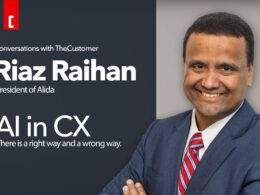Just as customer data is becoming more and more valuable, customers are becoming more concerned about how their data is being used. Simultaneously, they are becoming more powerful and have greater control over their digital lives. Witness the European Union’s General Data Protection Regulation (GDPR), the right to be forgotten, “deep delete,” and laws governing data sovereignty. With rising populism and surveys around the world consistently showing that trust in companies (and all institutions) is rapidly eroding, businesses should be prepared for these concerns to intensify.
We’re all consumers ourselves, and as such, leaders can understand the anxiety when very personal and private aspects of our lives may be disclosed by the digital traces we leave in cyberspace. Even to be willing to share their data with a company, customers need to trust that the company won’t re-purpose or re-sell the data downstream in ways they might find inscrutable or objectionable. They need to trust that their data is reasonably secure against cyber breaches and that the company will do the right thing if a breach should occur.
But now, imagine customers who are not only willing to share their data with a company, but eager to share more of it. What would this take? Most fundamentally, customers would need see that their data is being used for their benefit, in ways that they highly value. If that happens, they will be eager to share more about themselves to receive even more value.
It’s time for many organizations to ask themselves: How is the data about customers being used to help customers?
Consider the way insurance companies use our data. It’s typically product-centric — using actuarial algorithms to create a transaction for specific amounts of coverage. But what if an insurance company used novel forms of big data in customer-centric ways? They might create products to help drivers better understand their (or their family members’) driving behavior to incent safer driving. This is the essence of customer-centricity: using data to help people better achieve their own goals, rather than just using it to price or segment or target customers.
Another example comes from recommender algorithms. Such algorithms have greater and greater influence over our daily lives, shaping our experiences. But what you’re “likely” to buy isn’t necessarily what you’ll be happy having bought. What you’re likely to click or watch or read isn’t necessarily what will enrich your life. Companies that leverage data for the consumer’s benefit have a real opportunity to differentiate by targeting not just what we will click, but what is compelling on a deeper level; not just what we are a likely to buy, but what is likely to spark joy. This deeper utility to the customer is why the disciplines of human-centric AI will become essential, touching not just design, but even unexpected areas like social science, psychology, art, and the humanities.
So how can companies demonstrate compelling consumer-centric value and create trusted data relationships with them? We believe there are several starting points:
- Use the data you already have to benefit the customer. Customers intuitively have a sense when data is being used to benefit the company, rather than to deliver more value for themselves. In fact, a growing amount of data is just being stored in data warehouses without being used at all. When it is being used, it’s mostly to more efficiently target customers so that more revenue can be generated at lower cost. Going back to the data you already have with a customer-centric lens and the disciplines of human-centric AI is bound to uncover new avenues for delighting your customers with the data they’ve already entrusted to you.
- Think about the whole customer, across the whole life cycle. Harnessing the potential of data also requires a shift from a narrow transactional focus. Instead, companies will need to explore how they can enhance value in a much broader context — pre-sale and post-sale. Remember that offering proactive data insight sometimes requires a high degree of intimacy and implicit permission, and can feel awful when it goes wrong. But when it’s natural and helps customers get far more value from the product or service they have purchased, it’s perfect. For example, what if supermarket data generated not just coupons, but tailored recipe suggestions? “If you have any chicken left over, you may want to use it with the cilantro and yogurt you bought in the following way.” We already know the supermarket has this data, and the suggestion could help break up cooking monotony. The key is understanding what would be welcome in an individual, and evolving, context.
- Prepare to refocus your operations. As companies evolve and begin to better tailor their products, services, and experiences based on the insights gleaned from data, we are likely to see a significant transformation of their internal operations. They will have to reassess their current focus on highly standardized business processes, shifting to more tailored customer interactions that respond to the unique and evolving needs of individual customers. Data will help with this — giving more real-time and rich insight into each customer that will enable employees to tailor their activities on the fly and deliver greater value. However, these expanded and tailored uses of data will only be possible if companies are at the same time able to build in appropriate privacy controls to maintain regulatory compliance, protect the brand, and preserve customer confidence. To do so, companies will require more sophisticated security and privacy practices — such as Privacy by Design (PbD), which builds appropriate privacy controls into the design and operation of IT systems, networked infrastructure, and business practices.
These shifts will no doubt be challenging. But the rewards will be substantial, both for customers and the companies that serve them. It may turn out that the best way to generate profits is by helping customers to get more and more value from the products and services they use. The companies that figure this out will most likely be the ones that thrive in increasingly demanding markets.
Competitive advantage in this evolving world rests with trust and value. Technology is a powerful enabler, but it is only an enabler. Businesses that harness the power of data to create more and more value for their customers are the ones that will be most likely to grow trust and gain privileged access to data.














